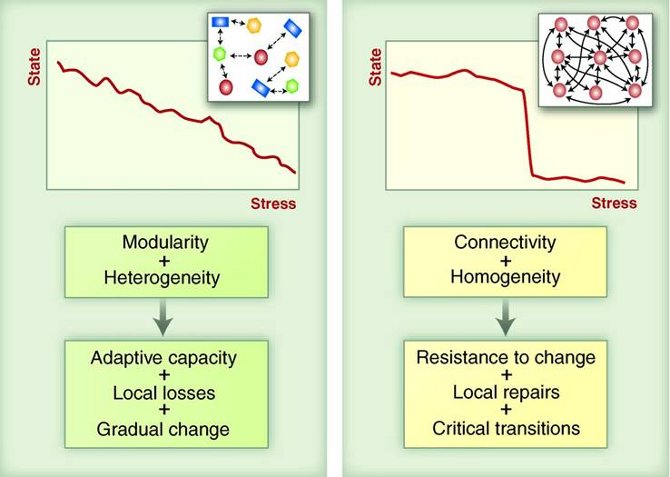- Home
- » Complexity Theory
- » Connectivity
Connectivity
The changes that we observe in system states are essentially the manifestation of changes in the interactions or connections between different system elements. When you 'look' unwell you know that the reason has to do with changes inside your body! Broadly speaking, connectivity in a real world system is the way and degree to which energy, resources, species and social actors interact within a network. There is considerable theoretical understanding about how the shape of the network and its connections affects the function of the system. For example, naturally evolved, self-organized networks like ecosystems and the internet tend to be resilient to localised failures but vulnerable to the loss of major network hubs, like keystone species or major computer servers. While engineered systems, like power grids, tend to be resilient to hub loss but more vulnerable to local failure. The number of connections is also important. A relatively dense set of connections is normally associated with resilence because recovery following a local impact or failure is helped by the unaffected parst of the network that can renew the connections. However, very dense and highly connected systems, and this very much applies to social systems like global banking, can be far less resilient to disturbance because a local perturbation can cause a domino effect that rapidly cascades across the whole system. The 2007 banking crisis may well be an example of a hyper-connected and homogenous system that lacked internal barriers to damaging cascades. If we could track the changes in the connections of real world social-ecological systems we might have a strong basis for anticipating future changes. The figure illustrates how network connectivity will determine the speed and hence our adaptability or resistance to change.

Figure: Diverse and structured networks lead to adaptive capacity and gradual change where local losses are accepted, whereas highly connected and uniform networks tend to create an atmosphere of resistance to change where attempts to make short term or local repairs (instead of accepting local losses) make abrupt and unmanagable change much more likely (Scheffer et al., 2012).


 中文版本
中文版本

